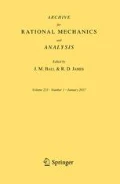Abstract
We consider evolutionary PDE inclusions of the form
where \(\mathscr {R}_1\) is a positively 1-homogeneous rate-independent dissipation potential and \(W_0\) is a (generally) non-convex energy density. This work constructs solutions to the above system in the slow-loading limit \(\lambda \downarrow 0\). Our solutions have more regularity both in space and time than those that have been obtained with other approaches. On the “slow” time scale we see strong solutions to a purely rate-independent evolution. Over the jumps, we obtain a detailed description of the behavior of the solution and we resolve the jump transients at a “fast” time scale, where the original rate-dependent evolution is still visible. Crucially, every jump transient splits into a (possibly countable) number of rate-dependent evolutions, for which the energy dissipation can be explicitly computed. This, in particular, yields a global energy equality for the whole evolution process. It also turns out that there is a canonical slow time scale that avoids intermediate-scale effects, where movement occurs in a mixed rate-dependent/rate-independent way. In this way, we obtain precise information on the impact of the approximation on the constructed solution. Our results are illustrated by examples, which elucidate the effects that can occur.







Similar content being viewed by others
References
Acerbi, E., Fusco, N.: Semicontinuity problems in the calculus of variations. Arch. Ration. Mech. Anal. 86, 125–145, 1984
Agostiniani, V., Rossi, R.: Singular vanishing-viscosity limits of gradient flows: the finite-dimensional case. J. Differ. Equ. 263, 7815–7855, 2017
Knees, D.: On global spatial regularity and convergence rates for time-dependent elasto-plasticity. Math. Models Methods Appl. Sci. 20, 1823–1858, 2010
Malý, J., Ziemer, W.P.: Fine Regularity of Solutions of Elliptic Partial Differential Equations, Mathematical Surveys and Monographs. Applied Mathematical Sciences, vol. 51. American Mathematical Society, Providence 1997
Mielke, A., Paoli, L., Petrov, A., Stefanelli, U.: Error estimates for space-time discretizations of a rate-independent variational inequality. SIAM J. Numer. Anal. 48, 1625–1646, 2010
Mielke, A., Rossi, R., Savaré, G.: Modeling solutions with jumps for rate-independent systems on metric spaces. Discrete Contin. Dyn. Syst. 25, 585–615, 2009
Mielke, A., Rossi, R., Savaré, G.: BV solutions and viscosity approximations of rate-independent systems. ESAIM Control Optim. Calc. Var. 18, 36–80, 2012
Mielke, A., Rossi, R., Savaré, G.: Balanced viscosity (BV) solutions to infinite-dimensional rate-independent systems. J. Eur. Math. Soc. (JEMS) 18, 2107–2165, 2016
Mielke, A., Roubíček, T.: Rate-Independent Systems. Theory and Application, Applied Mathematical Sciences, vol. 193. Springer, Berlin 2015
Mielke, A., Theil, F.: On rate-independent hysteresis models. NoDEA Nonlinear Differ. Equ. Appl. 11, 151–189, 2004
Mielke, A., Theil, F., Levitas, V.I.: A variational formulation of rate-independent phase transformations using an extremum principle. Arch. Ration. Mech. Anal. 162, 137–177, 2002
Mielke, A., Zelik, S.: On the vanishing-viscosity limit in parabolic systems with rate-independent dissipation terms. Ann. Sci. Norm. Super. Pisa Cl. Sci. 13, 67–135, 2014
Minh, M.N.: Regularity of weak solutions to rate-independent systems in one-dimension. Math. Nachr. 287, 1341–1362, 2014
Rindler, F.: Calculus of Variations. Universitext. Springer, Berlin 2018
Rindler, F., Schwarzacher, S., Süli, E.: Regularity and approximation of strong solutions to rate-independent systems. Math. Models Methods Appl. Sci. 27(13), 2511–2556, 2017
Rudin, W.: Real and Complex Analysis, 3rd edn. McGraw-Hill, New York 1986
Scilla, G., Solombrino, F.: A variational approach to the quasistatic limit of viscous dynamic evolutions in finite dimension. J. Differ. Equ. 267, 6216–6264, 2019. 4001054
Thomas, M., Mielke, A.: Damage of nonlinearly elastic materials at small strain–existence and regularity results. ZAMM Z. Angew. Math. Mech. 90, 88–112, 2010
Triebel, H.: Function spaces in Lipschitz domains and on Lipschitz manifolds. Characteristic functions as pointwise multipliers. Rev. Mat. Comput. 15, 475–524, 2002
Ziemer, W.P.: Weakly Differentiable Functions, Graduate Texts in Mathematics, vol. 120. Springer, Berlin 1989
Acknowledgements
This project has received funding from the European Research Council (ERC) under the European Union’s Horizon 2020 Research and innovation programme, Grant Agreement No. 757254 (SINGULARITY). F. R. also acknowledges the support from an EPSRC Research Fellowship on Singularities in Nonlinear PDEs (EP/L018934/1). S.S. and J.J.L.V. acknowledge support through the CRC 1060 (The Mathematics of Emergent Effects) of the University of Bonn that is funded through the German Science Foundation (DFG). S.S. further thanks for the research support PRIMUS/19/SCI/01 and UNCE/SCI/023 of Charles University and the Program GJ19-11707Y of the Czech National Grant Agency.
Author information
Authors and Affiliations
Corresponding author
Additional information
Communicated by G. Dal Maso.
Publisher's Note
Springer Nature remains neutral with regard to jurisdictional claims in published maps and institutional affiliations.
Rights and permissions
About this article
Cite this article
Rindler, F., Schwarzacher, S. & Velázquez, J.J.L. Two-Speed Solutions to Non-convex Rate-Independent Systems. Arch Rational Mech Anal 239, 1667–1731 (2021). https://doi.org/10.1007/s00205-020-01599-z
Received:
Accepted:
Published:
Issue Date:
DOI: https://doi.org/10.1007/s00205-020-01599-z


